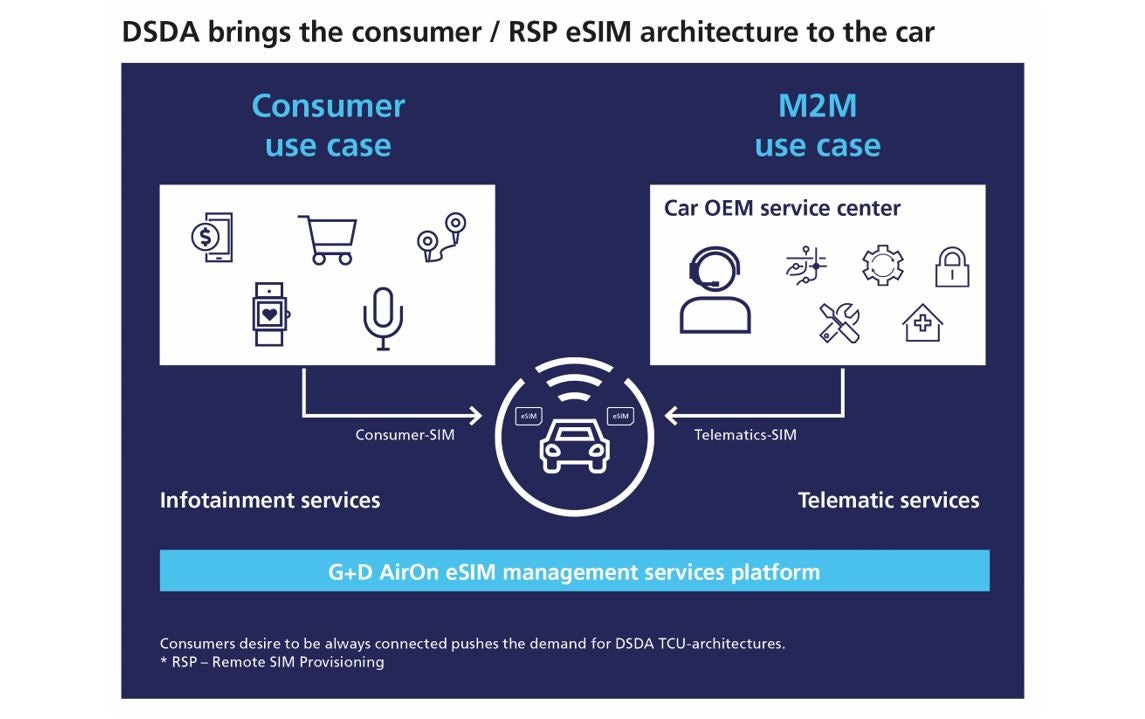
By Ralf Schedel, Director Domain Automotive in the Connectivity & IoT Business at Giesecke+Devrient
Driverless technology, electric batteries, and regenerative braking are just some of the features that will shape the future automobile. But, the driving experience of tomorrow also extends into personalised and seamless user experiences, and flexibility surrounding car connectivity decisions. Whilst consumers raise expectations for efficient in-vehicle connectivity, security, and privacy, the safety of the driver must remain at the forefront of innovation.
As more and more car functions are managed electronically and an increasing amount of data is transferred from various car sensors, automakers need to ensure that connected cars are well protected, meet regulatory requirements, and have sufficient bandwidth to avoid any disruption to the range of services that drivers can now access. It’s this balancing act that is critical to ensuring that millions of connected cars can be controlled efficiently and meet driver expectations.
The future of connected cars
So, what is enabling the success of the connected car? The answer is embedded SIM, or eSIM, technology. Devices that need a mobile connection are fitted with a SIM chip that enables connection to the mobile network. In cars, eSIM chips are built in that last their entire lifetime. By being embedded into an isolated hardware module, these SIMs act as the root of trust for connectivity-related services, authenticate the connected car against the network, and optionally sign and encrypt data.
For example, data from sensors inside and outside the vehicle power the algorithms that enable driver alerts, assistance, and advice. This could be, for example, the monitoring of driver fatigue and recommending a break to prevent an accident, or smart parking assistance to detect external hazards. This data can also be combined to provide even smarter insights. For example, the system may recommend that the driver continue on for an additional ten minutes to both rest and refuel due to the car running low.
With a standardised connectivity management service, alongside eSIM deployment, carmakers can control millions of connected cars efficiently. Through these platforms, car makers can run secure over-the-air remote provisioning and remote subscription management to eSIMs in order to link up the connected cars to their preferred carrier networks in the field.
Regulation is another key driver for car makers to deploy eSIM technology. From April 2018, the EU mandated that all new vehicles be fitted with an eCall system. This technology automatically triggers emergency services in the event of a serious accident. Data sent includes location information, direction of travel, and the vehicle model
Meeting bandwidth requirements
eSIMs are the gateway to secure and seamless driver experiences. Car-related services, such as telematics, require sufficient bandwidth on one side, and users also expect to use mobile connectivity for their personal digital entertainment services. It’s commonplace now for drivers to become instantly connected in their car . This is where dual-eSIM technology comes in, or in other words, two independent eSIMs for both the car and the driver. Dual-eSIM technology provides customers with an integrated connectivity experience through the option to take their Personal eSIM profile into the car. This way, the car runs under the data plan of their ‘home’ operator, just like customers are already used to doing when adding their smartwatch as a secondary device next to their smartphone to their existing data plan. The car is just another device they get instantly connected to when they enter it.
This means one eSIM handles all the car-centric services while the second eSIM allows car passengers to make use of their private data plan in the car, much in the way that other IoT devices such as wearables are utilised. From here, the car essentially becomes truly another mobile device. This is where the user experience can really be prioritised. Deep integration of the eSIM into the vehicle’s telematics and external antenna system guarantees superb signal transmission and reception.
This method also avoids the hassle associated with pairing the device via Bluetooth technology every time the driver starts the vehicle, and the service also extends to other users in the car. Multiple device IDs can allow other family members to access the entertainment system.
eSIM technology supports car makers in their transformation process
The global automotive industry is undergoing a significant transformation. Demographic, regulatory, and environmental pressures are increasing across the globe. eSIM technology opens up the door for agile reaction to changed environments, as well as optimised and personalised driver experiences. With this technology, users can benefit from services that enable more efficient and safe driving and manufacturers can gain peace-of-mind that data is being used in a way that complies with local laws and regulations.
It’s this blend of solutions, Telematics eSIM paired with eSIM consumer technology, that can work together to deliver the driving experience of tomorrow and keep car manufacturers at the forefront of innovation.
About Giesecke+Devrient
Giesecke+Devrient (G+D) is a global security technology group headquartered in Munich, Germany. As a reliable partner for international customers with the highest standards, G+D’s solutions safeguard the essential values of this world. The company develops customised technology, with passion and precision, in four core areas: payment, connectivity, identities, and digital infrastructures.
G+D was founded in 1852. In the fiscal year 2022, the company, with more than 12,600 employees, generated a turnover of €2.53bn. G+D is represented by 103 subsidiaries and joint ventures in 33 countries. For more information, please visit our website.


